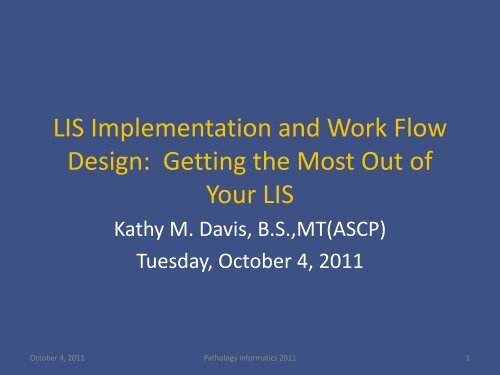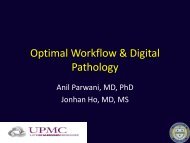LIS Implementation and Work Flow Design - Pathology Informatics ...
LIS Implementation and Work Flow Design - Pathology Informatics ...
LIS Implementation and Work Flow Design - Pathology Informatics ...
- No tags were found...
You also want an ePaper? Increase the reach of your titles
YUMPU automatically turns print PDFs into web optimized ePapers that Google loves.
What’s the Big Deal?• Laboratory systems are very integrated• Interface hubs reduce the impact of change on othersystems, but they do not eliminate it• Every hospital department <strong>and</strong> division has their ownagendas <strong>and</strong> priorities• Priorities are constantly shifting, especially duringlong implementations that are typical for <strong>LIS</strong>’s• HR issues – sabotage, nitpickers, slackersOctober 4, 2011 <strong>Pathology</strong> <strong>Informatics</strong> 2011 5
The Big Deal continued …• The <strong>LIS</strong> functionality you purchased may not beexactly what you expected• The development efforts may take a bit longer thanexpected• Resources for the project may become diluted withoperational responsibilities <strong>and</strong> other priorities• Vendors always want to sell additional solutions• Hospitals are on tight budgets <strong>and</strong> constantly needadditional IT solutions to remain competitiveOctober 4, 2011 <strong>Pathology</strong> <strong>Informatics</strong> 2011 6
Get Ready to LeadOctober 4, 2011 <strong>Pathology</strong> <strong>Informatics</strong> 2011 7
Securing the ResourcesPeople<strong>Work</strong> spaceHardware/softwareCommitment from topmanagementOctober 4, 2011 <strong>Pathology</strong> <strong>Informatics</strong> 2011 8
The PeopleProjectDirectorLabDirectors<strong>and</strong>ManagersConsultantsHospital <strong>and</strong>DepartmentalLeadershipProjectManagerProjectTeamsTeam LeadsOctober 4, 2011 <strong>Pathology</strong> <strong>Informatics</strong> 2011 9
The Project Director• MD - Pathologist <strong>and</strong>/or <strong>Pathology</strong> Resident• Manages the politics <strong>and</strong> pressures <strong>and</strong> provides theclout at the institutional level to resolve major issues• Provides MD representation at high level executive ITcommittees in the hospital• Communicates progress or concerns at departmentalAP <strong>and</strong> CP faculty meetings• Engages the <strong>LIS</strong> vendor leadership to resolve compleximplementation issues <strong>and</strong> to kindle developmentrelationships when appropriateOctober 4, 2011 <strong>Pathology</strong> <strong>Informatics</strong> 2011 10
The Project Manager• <strong>Work</strong>s to ensure top management commitment for theproject• Forms the project teams• Coordinates all project activities– Overall project planning– Internal operational meetings– Manages the project plan– Training schedules– Database build activities– Problem <strong>and</strong> issue tracking– Testing <strong>and</strong> validation activities– <strong>Implementation</strong> schedules• Ensures the project is delivered with the functionality <strong>and</strong>workflow required, on time, <strong>and</strong> within the budget.• CommunicatesOctober 4, 2011 <strong>Pathology</strong> <strong>Informatics</strong> 2011 11
The Teams• Laboratory Core team– Medical Technologists– Lab IT support staff– Desktop support– Systems support• Interface team– HIS, CPOE, Outreach portals, etc.• Laboratory Leadership team– Laboratory directors– Laboratory managersOctober 4, 2011 <strong>Pathology</strong> <strong>Informatics</strong> 2011 12
Forming the Teams• Medical technologists with an aptitude forinformation management– Horizontal integration into the laboratories• Central IT staff with desire to change job roles• Internal vs. external c<strong>and</strong>idates• Experienced vs. inexperienced• Full time project staff vs. staff with existingoperational responsibilitiesOctober 4, 2011 <strong>Pathology</strong> <strong>Informatics</strong> 2011 13
Team Leads• Coordinate the subprojects of the implementation– CP – general lab, blood bank, microbiology– AP – Anatomical pathology, cytology, genetics, flow– Data cross load– Desktop <strong>and</strong> peripherals– Patient <strong>and</strong> management reports– Outreach– Specimen management– System management– Testing <strong>and</strong> validationOctober 4, 2011 <strong>Pathology</strong> <strong>Informatics</strong> 2011 14
Consultants• Consultants– Extra lead time– On boarding <strong>and</strong> off boarding– Risk that the operational support staff will lack thedepth of knowledge necessary to maintain thesystems post implementation– Dedicated staff that can focus on the project– May become eligible c<strong>and</strong>idates for permanentemploymentOctober 4, 2011 <strong>Pathology</strong> <strong>Informatics</strong> 2011 15
Directors, Managers, <strong>and</strong>Top Leadership• Must ensure that the project is visible at the highestlevel of the hospital• Must ensure that upper management supports,embraces, <strong>and</strong> is made aware of the degree of effortrequired to implement an <strong>LIS</strong>• Must include MD leadership because many of thebusiness decisions <strong>and</strong> priorities are established byMDs in the healthcare environmentOctober 4, 2011 <strong>Pathology</strong> <strong>Informatics</strong> 2011 16
The <strong>Work</strong> Room• A separate work space is recommended for theproject team• Configuring <strong>and</strong> building a new <strong>LIS</strong> is oftenfrustrating <strong>and</strong> those frustrations are confined withinthe room• Teams working together promotes rapidcommunication <strong>and</strong> problem resolution• Room configuration takes time – multiple desktops,networking, communicationsOctober 4, 2011 <strong>Pathology</strong> <strong>Informatics</strong> 2011 17
<strong>Work</strong>spaceOctober 4, 2011 <strong>Pathology</strong> <strong>Informatics</strong> 2011 18
Hardware, Software, <strong>and</strong>Environments• Where will the servers be located?– Centralized IT vs <strong>Pathology</strong> Machine room• Who manages the servers?– Central IT staff or <strong>Pathology</strong> IT support team• Plans for redundancy; disaster plans• How many “environments”– LIVE– TEST– Development– OthersOctober 4, 2011 <strong>Pathology</strong> <strong>Informatics</strong> 2011 19
Server RoomOctober 4, 2011 <strong>Pathology</strong> <strong>Informatics</strong> 2011 20
Project ComponentsProjectManagementToolsInterfacesProject PlansCommunicationPlansPrioritiesCo-DevelopmentKeeping theLights OnOctober 4, 2011 <strong>Pathology</strong> <strong>Informatics</strong> 2011 21
Effective Communication• Vendor communication– Overall project management checkpoints– Project development checkpoints– Weekly checkpoints for each module– Monthly on site sessions– Weekly file builds <strong>and</strong> workflow planning using on line collaborationtools• Hospital leadership communication– Representation on hospital IT committee meetings• Laboratory communication– Staff meetings– Periodic IT forums– Laboratory committee meetings or operational meetings– Project website– Newsletters• IT communication– Staff meetings– EmailOctober 4, 2011 <strong>Pathology</strong> <strong>Informatics</strong> 2011 22
Project Management Tools• Comprehensive project plan• Time lines• Weekly or bi-weekly work plans• Status reports• Issue tracking– Enhancement requests– Defect management• Keep the process simpleOctober 4, 2011 <strong>Pathology</strong> <strong>Informatics</strong> 2011 23
Managing Multiple ProjectsProjectmanagementDevelopmentactivitiesHistorical datacross loadInitial trainingCore file buildTest file buildInterfaces toother systemsInstrumentinterfacesManagementreportsPatient reportsDesktop <strong>and</strong>devicesEnd usertrainingIntegrationactivitiesPatientManagementOrderManagementSpecimenManagementResultManagementOutreachPolicies,procedures, <strong>and</strong>SOPsValidation <strong>and</strong>testingdocumentation<strong>Implementation</strong>planningGO LIVEOctober 4, 2011 <strong>Pathology</strong> <strong>Informatics</strong> 2011 24
The Co-Development Culture• Whether or not your site engages in development initiativeswith the <strong>LIS</strong> vendor is an important decision• Success depends on the “culture” of an institution• Some institutions are not prepared to meet the dem<strong>and</strong>s ofco-development initiatives• Development efforts require staff resources <strong>and</strong> kindling thedevelopment relationship with the vendor can be challenging• The goal of co-development efforts should reflect satisfactionat your site <strong>and</strong> improved marketability for the vendorOctober 4, 2011 <strong>Pathology</strong> <strong>Informatics</strong> 2011 25
A Bit About Keeping the Lights On• Not a trivial pursuit• <strong>LIS</strong> systems are complex <strong>and</strong> typically with many value addedapplications that also require care <strong>and</strong> feeding• The business of healthcare today is very competitive <strong>and</strong> theneed for IT solutions is continuous in our quest to improvepatient safety <strong>and</strong> to add efficiencies to our workflow, allwhile reducing our FTEs• There is a constant flow of requests that range from processimprovement initiatives for existing workflow to thedevelopment of custom solutions or incremental systemsrequired to support the outreach programs• Almost every change in healthcare involves IT, even if it’s justrearranging office space or moving across townOctober 4, 2011 <strong>Pathology</strong> <strong>Informatics</strong> 2011 26
A Word About Prioritization• EXTREMELY difficult job• Should be the responsibility of an oversightleadership team, but often is not• Addressing patient safety risks should always be apriority• Addressing requests for features <strong>and</strong> functionalitythat compete in the healthcare marketplace arestrongly driving project priorities• Meaningful useOctober 4, 2011 <strong>Pathology</strong> <strong>Informatics</strong> 2011 27
Time Lines <strong>and</strong> Shifting Priorities• Time lines – be prepared to be flexible– <strong>LIS</strong> implementations are complex <strong>and</strong> projectedtime lines typically require adjustments– 50% increase for high confidence factor– 100% increase for low confidence factor– 200% increase for high risk projects– Double the time recommended by the vendorOctober 4, 2011 <strong>Pathology</strong> <strong>Informatics</strong> 2011 28
Time Lines <strong>and</strong> Shifting Priorities• Departmental m<strong>and</strong>ates– Frequent laboratory instrumentation changes– Validation activities for updates to otherinterfaced systems– Requirements to support outreach programinitiativesOctober 4, 2011 <strong>Pathology</strong> <strong>Informatics</strong> 2011 29
Time Lines <strong>and</strong> Shifting Priorities• External m<strong>and</strong>ates– During your <strong>LIS</strong> implementation the hospitalimplements EPIC at a rapid pace– <strong>LIS</strong> implementation at the hospital is postponed– Current <strong>LIS</strong> must be extended <strong>and</strong> version upgradeis requiredOctober 4, 2011 <strong>Pathology</strong> <strong>Informatics</strong> 2011 30
Ripple Effect• Additional project time can be an advantage– Later versions of software with more enhancementsat go live– Extended time for development initiatives• Extended timelines are not always bad• “When things go wrong, you’ll find they usually go ongetting worse for some time; but when things once startgoing right they often go on getting better <strong>and</strong> better.”C.S. LewisOctober 4, 2011 <strong>Pathology</strong> <strong>Informatics</strong> 2011 31
Interfaces• Review specifications for each interface– Do you have an interface integration engine?– Controls in application or interface engine– Eclipsys, EPIC, Atlas, etc.– Custom value added applications• Assess the impact of new <strong>LIS</strong> to existing systems– Internal hospital systems– Outreach systems– OthersOctober 4, 2011 <strong>Pathology</strong> <strong>Informatics</strong> 2011 32
Executing the projectDatabase or filebuild training<strong>Implementation</strong>ActivitiesFile Build foreach moduleOperationalAnalysis <strong>and</strong><strong>Work</strong>flow <strong>Design</strong>Validation <strong>and</strong>TestingInterfaceTestingEnd UserTrainingOctober 4, 2011 <strong>Pathology</strong> <strong>Informatics</strong> 2011 33
File Build Training• Often takes place at vendor site• Takes several weeks / months to cover all aspects ofthe system• Ensure system is ready for use when the build teamreturns from training• Make sure training is scheduled for current release orthat arrangements are made to receive trainingdocumentation once available by the vendorOctober 4, 2011 <strong>Pathology</strong> <strong>Informatics</strong> 2011 34
Operational Assessments <strong>and</strong> GapAnalysis• Vendor on site to review laboratory workflow beforefile builds begin• Identify possible challenges for the vendor tosupport current workflow• Identify possible laboratory workflows that may berequired for new <strong>LIS</strong>• Identify plans to reconcile differences in labexpectations <strong>and</strong> vendor capabilities• Customizations vs. Enhancements vs. ProductDefectsOctober 4, 2011 <strong>Pathology</strong> <strong>Informatics</strong> 2011 35
Database build considerations• Build the common files– Usernames / passwords– Location files (nursing units, clinics, etc.)– Specimen types– Specimen containers– Reporting units (st<strong>and</strong>ardized)• Build the tests– Upper case/ lower case– Order codes naming conventions– Instrument interfaces• Configure interfaces to other systems– Hopefully the customers are known <strong>and</strong> are in the loop– Controlling timelines <strong>and</strong> validation efforts is a challengeOctober 4, 2011 <strong>Pathology</strong> <strong>Informatics</strong> 2011 36
<strong>Work</strong>flow <strong>Design</strong>• Opportunities to implement LEAN processing– Current state workflow vs. future state workflow– Reduce processing waste• Complex workflows– Research accounts– Research specimen collection tubes– Sendout tests– Call back <strong>and</strong> fax back requests– Shared specimens– Integration between modules– Integrated reportsOctober 4, 2011 <strong>Pathology</strong> <strong>Informatics</strong> 2011 37
Integrated Reports <strong>Work</strong>flow• The integrated report– Interpretation summary for the bone marrow biopsy,cytogenetics report, molecular report, <strong>and</strong> flow report• Which reports get integrated <strong>and</strong> how is thisflagged?• Which pathologist is responsible to produce theinterpretation summary?• How is billing h<strong>and</strong>led – or is it?October 4, 2011 <strong>Pathology</strong> <strong>Informatics</strong> 2011 38
End User Training• Technical writer role to prepare customized end usertraining materials• Training the trainer approach• On line training modules• Keep end user training close to Go LiveOctober 4, 2011 <strong>Pathology</strong> <strong>Informatics</strong> 2011 39
Validation <strong>and</strong> Test Plans• Sub-committee– Blood Bankers are good choice to lead this work group• Technical writer provides expertise• Unit testing, Integrated testing• Documentation requirements– Paper– ElectronicOctober 4, 2011 <strong>Pathology</strong> <strong>Informatics</strong> 2011 40
Computer Validation Plan• Purpose• System Description <strong>and</strong> Scope• Criticality <strong>and</strong> Complexity• Validation Approach– Validation plan <strong>and</strong> documentation– System documentation– Test plan <strong>and</strong> scripts– Security– Change control• Review <strong>and</strong> approval signaturesOctober 4, 2011 <strong>Pathology</strong> <strong>Informatics</strong> 2011 41
Don’t Forget about RegulatoryRequirements!October 4, 2011 <strong>Pathology</strong> <strong>Informatics</strong> 2011 42
CAP GEN.43022• GEN.43022• There is documentation that programs areadequately tested for proper functioning when firstinstalled <strong>and</strong> after any modifications, <strong>and</strong> that thelaboratory director or designee has approved the useof all new programs <strong>and</strong> modifications.October 4, 2011 <strong>Pathology</strong> <strong>Informatics</strong> 2011 43
CAP GEN.43055• GEN.43055• There is documentation that all users of thecomputer system receive adequate traininginitially, after system modification <strong>and</strong> afterinstallation of a new system.October 4, 2011 <strong>Pathology</strong> <strong>Informatics</strong> 2011 44
CAP GEN.48500• GEN.48500• There is a procedure to verify that patient results areaccurately transmitted from the point of data entry(interfaced instruments <strong>and</strong> manual input) to patientreports (whether paper or electronic).October 4, 2011 <strong>Pathology</strong> <strong>Informatics</strong> 2011 45
<strong>Implementation</strong>• <strong>Implementation</strong> plans• Go Live Readiness Assessment• Conversion / cutover plans• Downtime planning• Staffing for conversion• Staffing for post go liveOctober 4, 2011 <strong>Pathology</strong> <strong>Informatics</strong> 2011 46
Thank You!kuzina@med.umich.eduOctober 4, 2011 <strong>Pathology</strong> <strong>Informatics</strong> 2011 47









